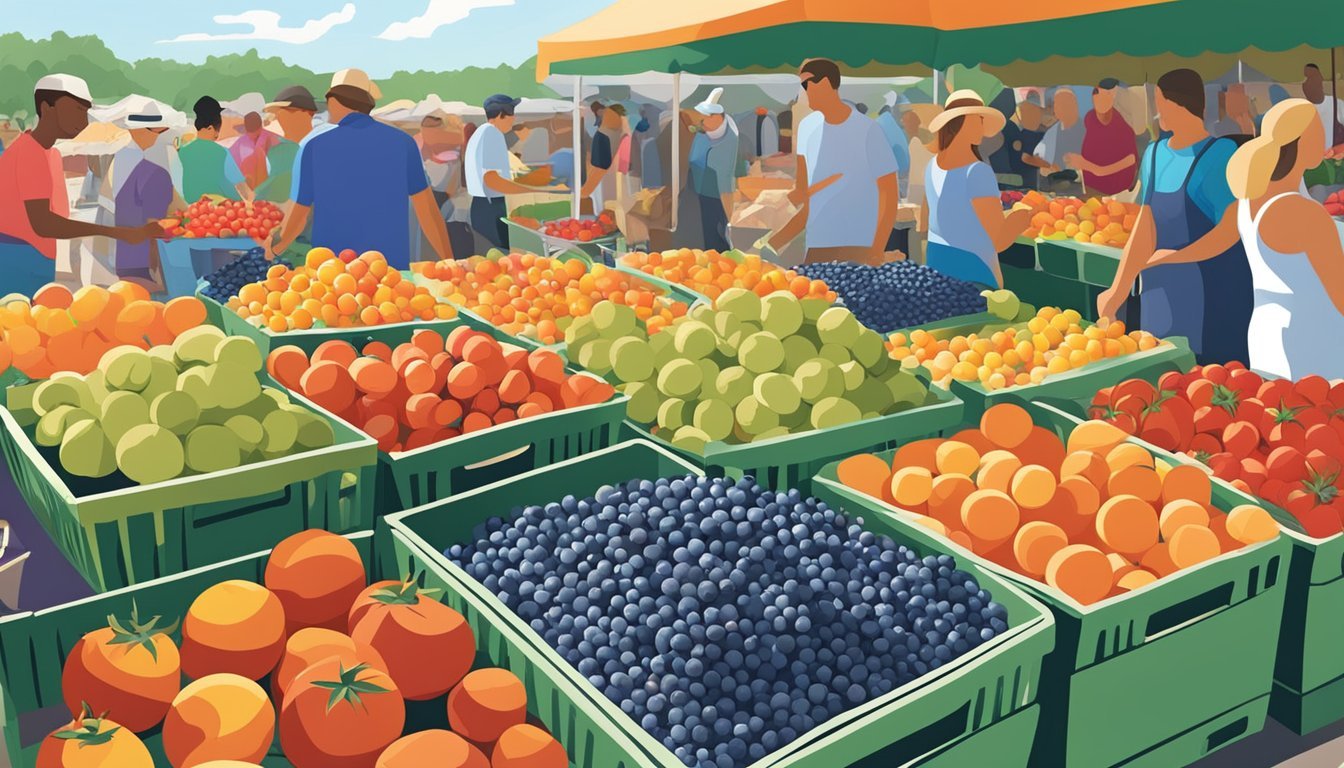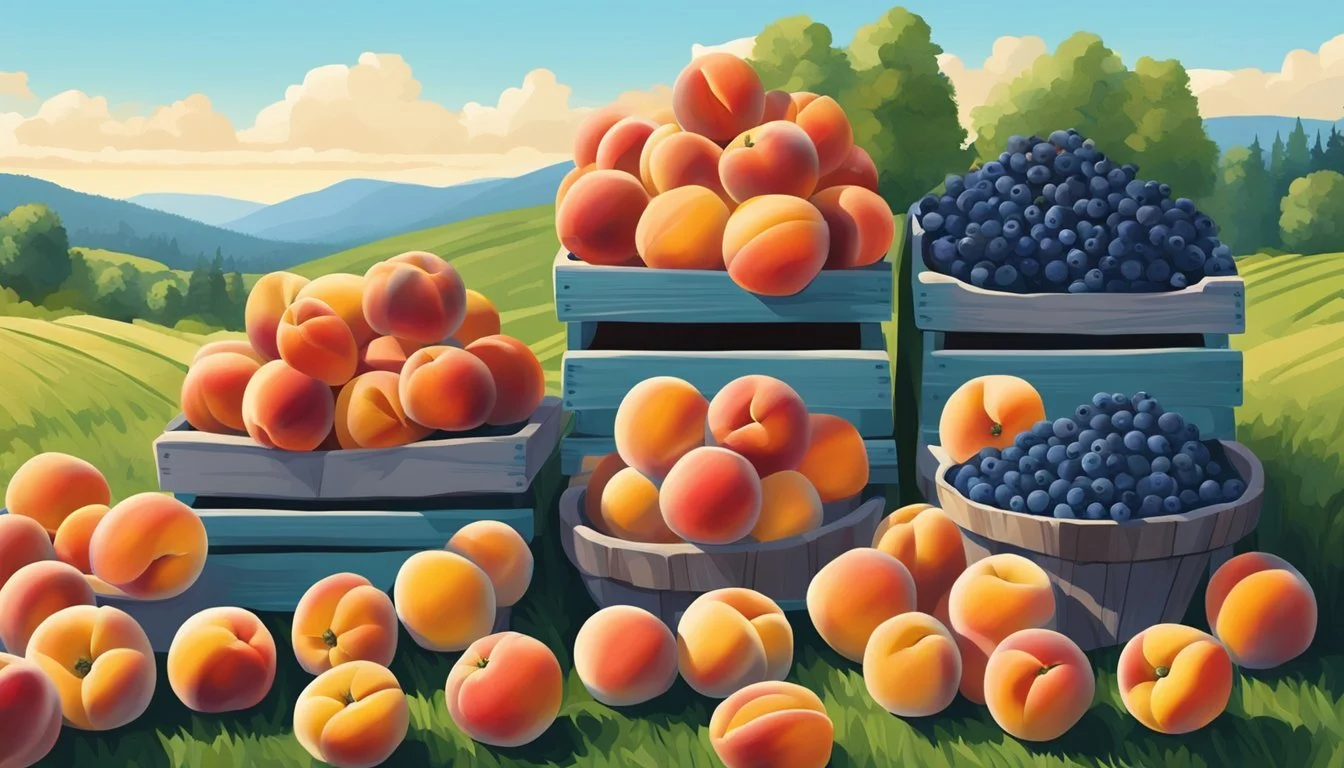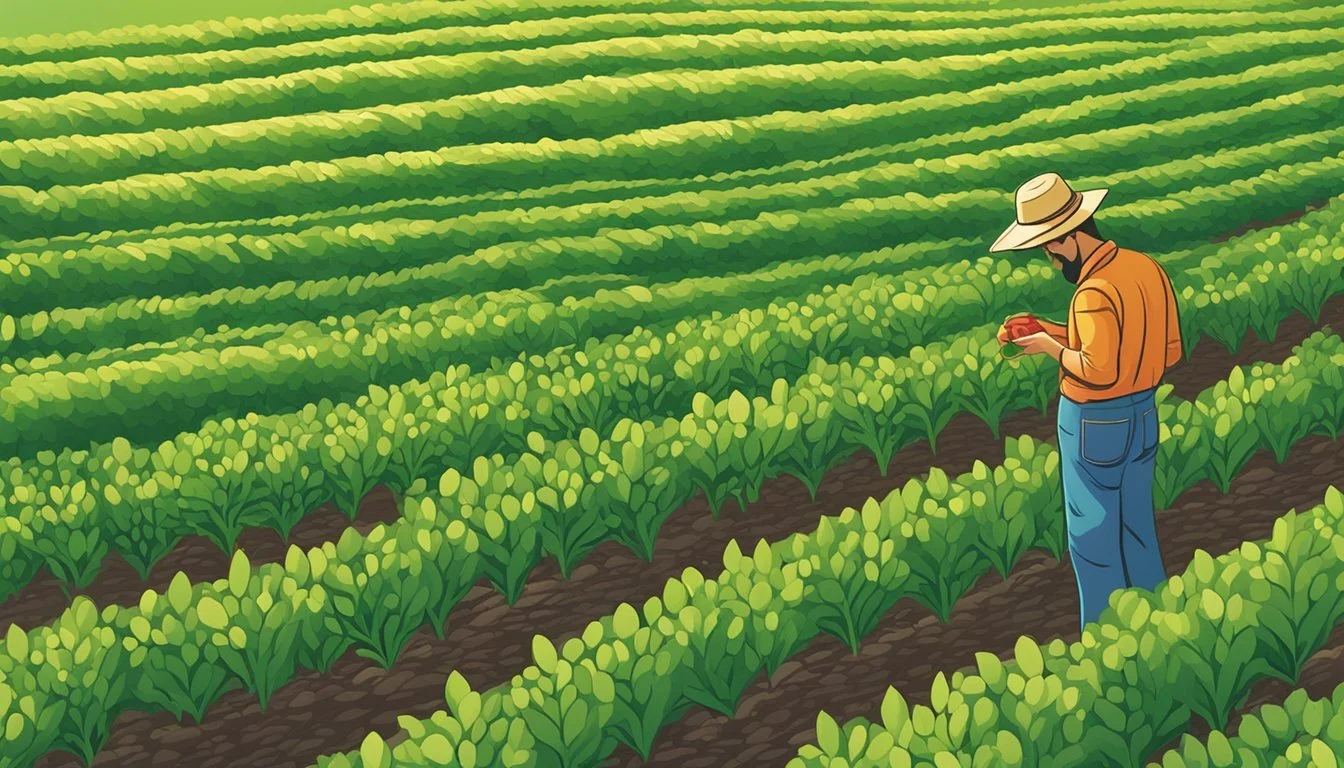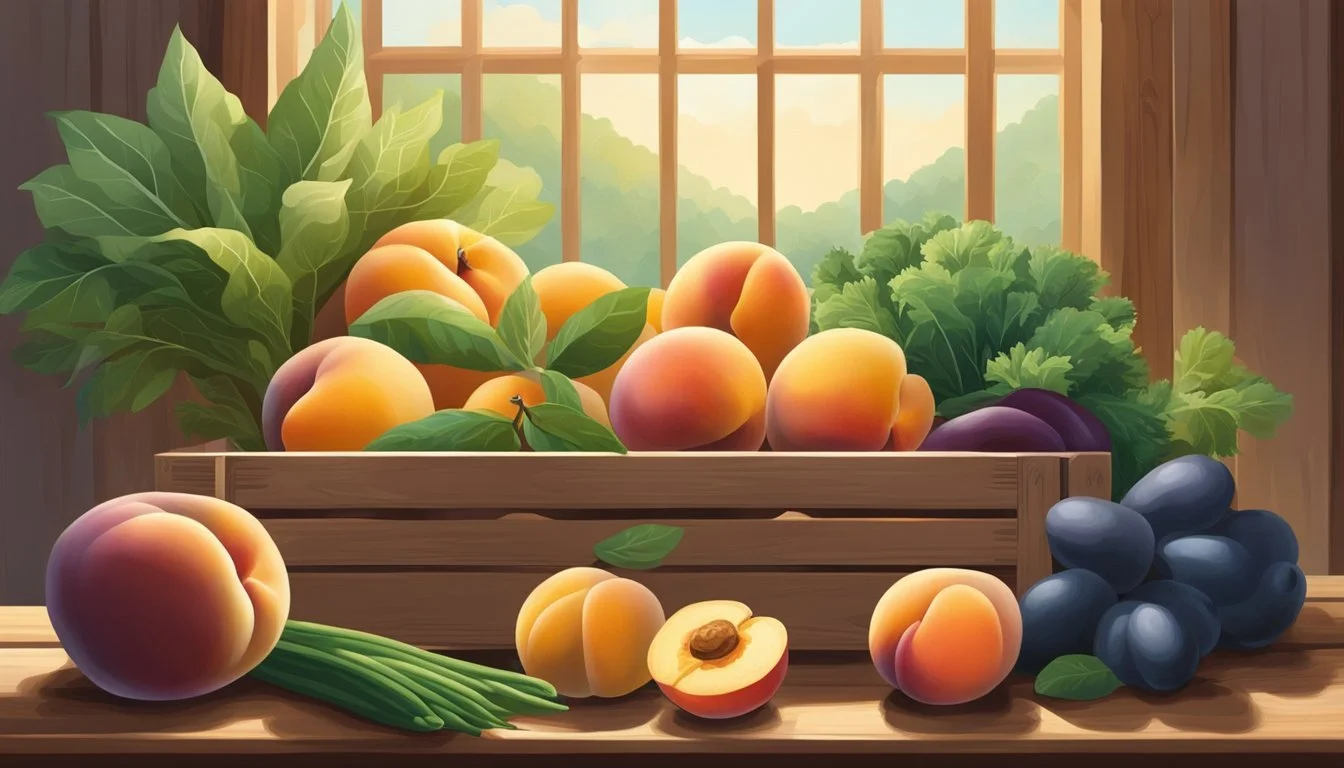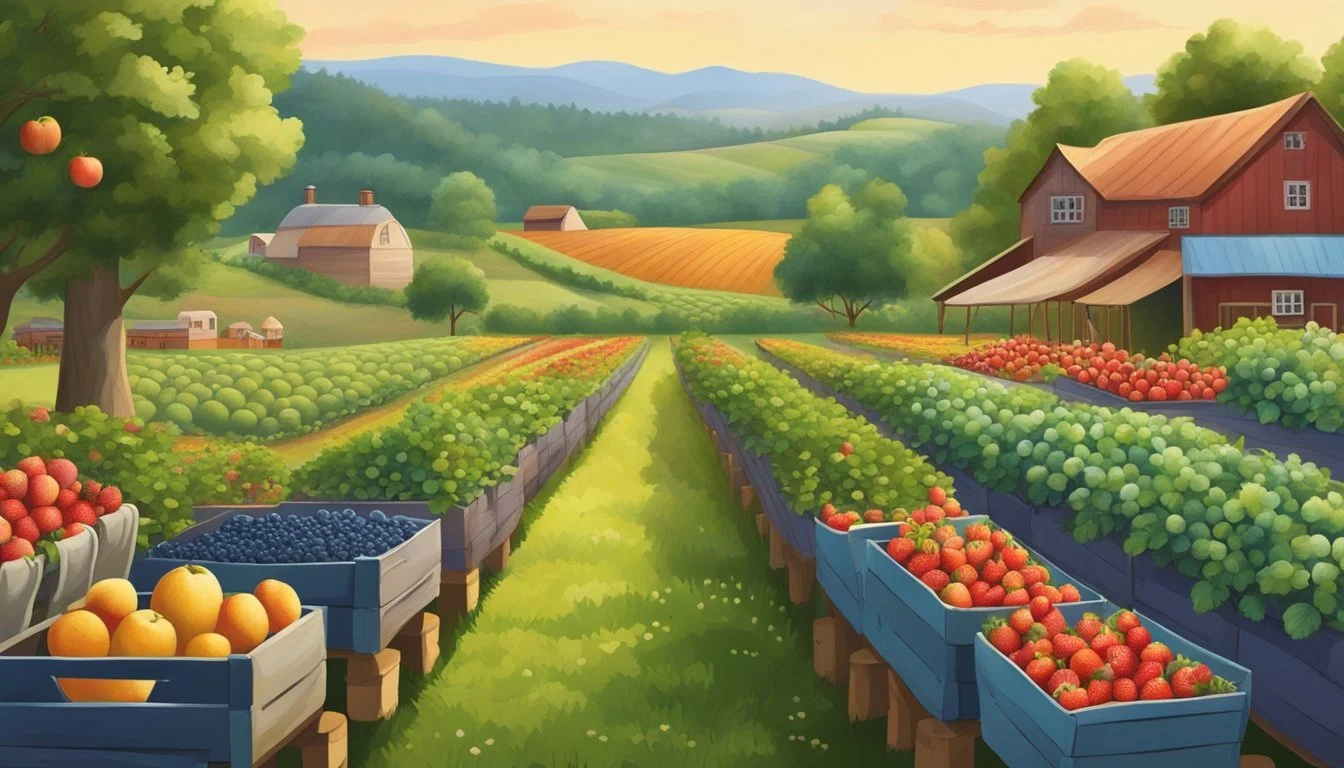New Hampshire Seasonal Fruit & Vegetables in August
Your Guide to Local Produce
This Article is Part of our New Hampshire Seasonal Fruit & Veg Calendar
August in New Hampshire is a bountiful month, a time when the state’s farms and gardens are teeming with a variety of fruits and vegetables at the peak of their freshness. This period marks a high point in the local agricultural calendar, with summer's warm temperatures helping to bring many crops to harvest. Residents and visitors alike have the opportunity to enjoy a rich selection of produce, ranging from the sweet juiciness of stone fruits to the crisp freshness of garden vegetables.
The fruit harvest includes succulent favorites such as blueberries (how long do blueberries last?) and peaches, with the latter often reaching perfect ripeness in the warmth of the late summer sun. Local farm stands and markets also display a colorful array of vegetables, including ripe tomatoes, which are particularly flavorful this time of year. The abundance of such produce not only adds vibrancy to the culinary landscape but also supports the local economy and sustainability efforts.
During this season, New Hampshire's agricultural offerings reflect the commitment of its farmers to providing high-quality, locally-grown fruits and vegetables. Those looking to experience the fresh taste of the season can find a plethora of options, from the tart snap of early apples (how long do apples last?) to the earthy robustness of summer squash. With a climate conducive to a wide array of crops, August is a month that showcases the richness of New Hampshire’s agricultural heritage.
Seasonality and Harvest Schedules
August in New Hampshire marks a period of abundance for both fruits and vegetable harvests. The region's growing season is at its peak, providing a rich bounty of fresh produce.
In terms of vegetables, consumers can expect to find a variety of leafy greens, such as lettuce and spinach, which thrive in the warm summer climate but have a quick turnaround and can be planted and harvested multiple times throughout the season. Root vegetables, like beets and carrots, also continue to be harvested during this time.
The fruit harvest in August offers a particularly sweet selection. Apples such as the Gravenstein, known for its early ripening, become available. Other apple varieties, such as McIntosh and Cortland, start to ripen by mid-August, signaling the onset of the fall apple season.
Here's a glance at key harvests during August:
Fruits:
Gravenstein Apples: Late August
McIntosh Apples: Early September
Peaches: August
Vegetables:
Beets: Throughout summer
Carrots: Throughout summer
Spinach: Quick harvests throughout summer
The transition from summer to fall is evident as the harvest schedule shifts from summer favorites such as peaches, to the heartier, storied fall varieties of apples. Winter preparations begin with the late-season vegetables that will store well into the cooler months.
It's imperative for local consumers and farmers' markets alike to align with the harvest calendar to ensure optimal freshness and support sustainable agricultural practices. New Hampshire's harvest schedule provides a roadmap for eating seasonally and sourcing the freshest, locally-grown produce.
Fruits in Season
In New Hampshire, August is a prime month for a variety of fresh fruits. From ripe berries to juicy stone fruits, the selection is diverse and bountiful, providing something to satisfy every palate.
Berries
Blueberries: They are at their peak, offering a sweet and tangy flavor. Raspberries: August finds raspberries ripe for the picking, with their rich red hue and burst of flavor. Strawberries: While their season is typically earlier, some late varieties may still be available.
Stone Fruits
Peaches: This is the prime time for peaches, which are juicy and full-flavored in August. Plums: They come into season, offering a sweet taste with a hint of tartness.
Melons
Watermelon: A summer staple, watermelon is available and at its best, synonymous with refreshing sweetness. Cantaloupe (how long does cantaloupe last?): This melon is also in season, providing a soft, perfumed flesh that is perfectly ripe.
Tree Fruits
Apples: Early varieties of apples begin to appear, signaling the start of the season. Pears: They typically start to ripen during late August, offering a variety of flavors and textures.
Vegetables in Season
In New Hampshire, August’s warm days and cool nights create an ideal climate for a variety of vegetables, offering an array of flavors and textures to the local cuisine.
Leafy Greens
Kale: Known for its resilience, kale reaches peak quality in August, boasting rich, dark green leaves.
Lettuce: Varieties like romaine and leaf lettuce are crisp and perfect for summer salads.
Spinach: This nutrient-packed green is tender and flavorful during the month.
Chard: With vibrant stems, chard is both colorful and nutritious.
Arugula: Possessing a slightly peppery taste, arugula thrives in the current month.
Root Vegetables
Beets: They are at their sweetest now, with deep reds and goldens available.
Carrots: August yields crunchy and sweet carrots, ideal for both raw and cooked dishes.
Radishes: Their pungent spice adds dimension to summer dishes.
Turnips: Often overlooked, turnips are versatile and have a mildly spicy flavor.
Summer Squash
Zucchini: Abundant in gardens, zucchini is a summer staple versatile in many recipes.
Cucumbers: (how long do cucumbers last?) Crisp cucumbers are perfect for refreshing salads or pickling.
Nightshades
Tomatoes: August brings a variety of tomatoes, from cherry to heirloom, with robust flavors.
Peppers: They come in a spectrum of colors, from sweet bells to spicy jalapeños.
Eggplant (What wine goes well with eggplant?): With a slightly spongy texture, eggplants are excellent for grilling or as a meat substitute in dishes.
Local Farming Practices
Farmers in New Hampshire have adapted to the region's climate by utilizing a mix of traditional and modern farming techniques to ensure a successful harvest of fresh produce. The local climate, characterized by warm summers and cold winters, shapes the growing season and the types of crops that can be cultivated.
Sustainable Agriculture:
They prioritize sustainable practices to maintain soil health and biodiversity.
Crop rotation and cover cropping are common to prevent soil depletion.
Integrated pest management (IPM) strategies are used to control pest populations with minimal chemical intervention.
Greenhouses and hoop houses extend the growing season and protect crops from early frost.
They enable the cultivation of less hardy plants and early start for seedlings.
Organic Farming:
Many farms opt for organic certification, refraining from using synthetic fertilizers and pesticides.
This approach aligns with increasing consumer demand for organic produce.
Pest and Disease Management:
Farmers closely monitor for signs of pest infestations and plant diseases.
They prefer biological and mechanical control methods over chemical ones.
Local Produce Availability:
Farmers' markets and local farm stands showcase the fresh produce.
Community Supported Agriculture (CSA) programs thrive, connecting consumers directly with local farms.
By committing to these practices, New Hampshire farmers not only contribute to the local food supply but also support the environment and regional economy. Their efforts ensure that consumers have access to high-quality, fresh produce throughout the various seasons.
Selecting and Storing Produce
When selecting fresh produce in New Hampshire during August, one should look for fruits and vegetables that are firm, vibrant in color, and free from visible damage. For example, cucumbers should be dark green without yellowing, while tomatoes are best chosen when evenly colored and slightly firm to touch, indicating ripeness and optimal flavor.
Storing produce correctly is critical for preservation and maintaining flavor. Most leafy greens, like lettuce, should be stored in the refrigerator's crisper drawer in a loosely closed plastic bag to retain their freshness. To prevent moisture accumulation, one might consider lining the bag with a paper towel. Lettuce and other greens are best consumed within a week for maximum flavor and nutrition.
Apples, which are just beginning their season, can be stored on the countertop if they will be eaten quickly but last longer in the fridge. For long-term preservation, apples can be sliced and frozen, ideal for later use in cooking or smoothies.
Tomatoes should generally be stored at room temperature away from direct sunlight to enhance their ripening and maintain their robust taste. Refrigeration can make tomato flesh mealy, so it should only be used when they are fully ripe and need to be preserved for a short period.
Cucumbers are best stored in the refrigerator, in the crisper drawer, to maintain their crisp texture. However, they should be consumed within a week as prolonged storage can lead to loss of flavor and a rubbery texture.
Freezing is an excellent option for extended preservation, especially for berries and sliced stone fruits. To freeze, wash the fruits, cut them as needed, spread them on a baking sheet to freeze individually, and then transfer to airtight containers or freezer bags. This method preserves the integrity and flavor for various uses throughout the year.
Nutrition and Health Benefits
August in New Hampshire brings a tapestry of fresh fruits and vegetables, each with its own set of nutritional advantages. These seasonal offerings provide a variety of vitamins, minerals, and antioxidants essential for a healthy diet.
Kale and spinach are leafy greens that pack a potent nutritional punch. Rich in vitamins A, C, and K, iron, and calcium, these vegetables support eye health, immune function, and bone strength. Their high fiber content also aids in digestion.
Apples are a delightful August fruit that contribute dietary fiber, vitamin C, and various antioxidants. Regular consumption can promote heart health and weight management.
Blueberries, bursting with flavor in August, are renowned for their high levels of antioxidants, particularly anthocyanins, which have been shown to reduce inflammation and possibly lower cancer risk.
Tomatoes are at their peak, offering vitamin C, potassium, folate, and lycopene—an antioxidant linked to heart health and sun protection.
Peppers come in a spectrum of colors and provide vitamin C, vitamin B6, and folate. These nutrients contribute to immune system health and energy levels.
Consuming these fruits and vegetables in their peak season in New Hampshire not only promises fresher taste but also ensures a higher nutrient content, as produce often loses vitamins during transportation and storage. Including a variety of these local, seasonal foods in one's diet can contribute to a diverse and nutritionally rich eating pattern, supporting overall health and wellness.
Culinary Uses and Recipes
In August, New Hampshire's fruition brings an abundance of vegetables and herbs that can transform meals with fresh, seasonal flavors. One can create vibrant dishes that not only showcase the freshness of local produce but also encourage healthier eating habits.
Kale is a hearty green that's excellent in salads, sautéed as a side dish, or incorporated into smoothies. For a simple meal, one might try a kale Caesar salad with homemade croutons (how long do croutons last?) and a light dressing. Basil and other herbs like thyme offer aromatic touches to any dish. Pesto made with fresh basil can serve as a versatile sauce for pasta, a spread on sandwiches, or a flavorful drizzle over grilled vegetables.
Here are some suggestions for using August's freshest ingredients:
Peppers: Stuff with a mixture of rice, beans, and seasonings for a fulfilling entrée.
Eggplant: Slice, grill, and layer with tomato sauce and mozzarella for a summer-friendly eggplant parmesan (What wine goes well with eggplant parmesan?).
Beans and Peas: Include in salads or stir-fries for added protein and texture.
Zucchini: Shred and fold into fritter batter, bake into bread, or spiralize for a low-carb noodle replacement.
Using these ingredients, one can craft a variety of recipes that reflect the bounty of New Hampshire in August. Whether it's a crisp salad featuring kale and herbs, or a comforting bowl of bean chili with peppers and zucchini, the possibilities are limitless. Seasonal produce not only offers superior taste and nutritional benefits, but also supports local agriculture and reduces the environmental impact of food transport.
Community and Agriculture Events
In August, New Hampshire bursts into a vibrant agricultural hub with numerous state and local community events centered around the harvest season. During this period, farmers markets abound, offering a wide variety of freshly harvested fruits and vegetables.
Farmers Markets: They become gathering spots for communities, providing access to the freshest produce directly from the growers. One can expect a range of stalls featuring heirloom tomatoes, crisp cucumbers, juicy peaches, and more. These markets often host live music and cooking demonstrations, enriching the shopping experience.
The Concord Farmers Market: Known for its wide selection, operating on Saturdays.
Portsmouth Farmers Market: Offers both morning and afternoon times, ideal for different schedules.
Agriculture Events: August also ushers in a series of dedicated agricultural events across the state. They aim to celebrate the season and the bounty it brings.
Harvest Festivals: These festivals typically include activities for all ages, such as hayrides, corn mazes, and tastings of local produce.
Local Impact: Events like these play a pivotal role in supporting the local economy and fostering a sense of community. They showcase the importance of sustainable farming practices and local food systems in New Hampshire.
It's a month rich in experience for both residents and visitors, encapsulating the spirit and flavors of the local landscape through its community events and agricultural celebrations.
Environmental Impact and Sustainability
When examining the month of August and its produce in New Hampshire, the environmental impact is a critical aspect to consider. Locally grown fruits and vegetables require less transportation, which significantly reduces greenhouse gas emissions.
Sustainable farming practices, such as the usage of organic methods, contribute to a healthier ecosystem. These practices reduce chemical runoff and improve soil quality, making them crucial for long-term agricultural viability.
Seasonality plays a prominent role in the environmental impact of produce. Seasonal fruits and vegetables in August, such as tomatoes, corn, and blueberries, tend to have a lower carbon footprint compared to out-of-season produce that often needs to be shipped from distant locations.
New Hampshire's farmers are increasingly facing climate-related challenges. Nonetheless, they are adapting through climate resiliency strategies that include planting drought-resistant crops and using water conservation techniques. This not only supports the stability of the local food system but also mitigates environmental stress.
Consumers can contribute by choosing seasonal and local options, thereby supporting sustainable practices and reducing their own environmental footprint.
Sustainable Choices Benefits Local Produce Reduces transportation emissions and supports local farmers. Organic Practices Minimizes chemical use and promotes biodiversity. Seasonal Foods Lower carbon footprint due to reduced need for long-distance transport. Climate Resiliency Ensures food production can continue despite changing weather patterns.
By supporting local agricultural practices that are aligned with sustainability and environmental preservation, New Hampshire residents can play a crucial role in fortifying their local food systems against the impacts of climate change.
Economic Aspects of Seasonal Produce
The economy of New Hampshire benefits significantly from the sale of seasonal produce. During August, local markets burst with fresh fruits and vegetables, such as tomatoes, sweet corn, and blueberries. This abundance presents an opportunity for the state's economy to flourish.
Farmers Markets play a pivotal role by acting as hubs for the sale of local produce. Consumers prefer these markets for purchasing fresh, locally grown products, thereby supporting the local economy and reducing the carbon footprint associated with long-distance transportation.
The state of New Hampshire encourages the consumption of seasonal produce through initiatives that support farmers and provide access to fresh food for all income levels. For example, the Women, Infants, and Children program (WIC) offers fruit and vegetable vouchers, enhancing economic stability for both consumers and producers.
On a larger scale, the United States' economy benefits from robust local agricultural sectors. Fresh produce exports and farm bill investments in fruits and vegetables demonstrate the significance of the sector at the national level.
Economic Benefit Description Job Creation Seasonal produce farming and market sales bolster employment. Local Revenue Direct sales at farmers markets contribute to the local financial system. State Support Economic programs assist in maintaining sustainable agriculture. National Impact Investments and exports reflect the industry's contribution to the US economy.
Seasonal produce not only sustains the health of consumers but is also a cornerstone in the economic well-being of New Hampshire and the wider United States.


